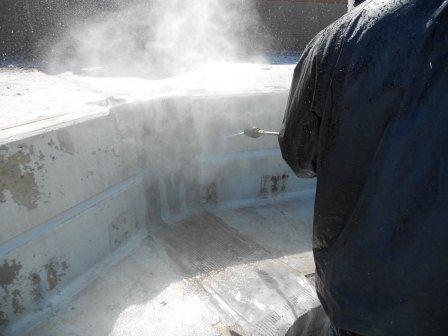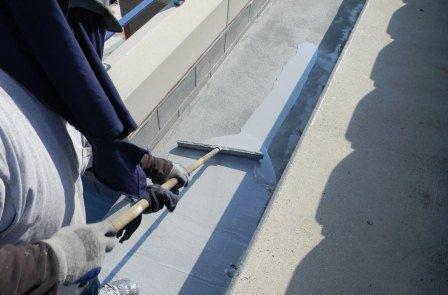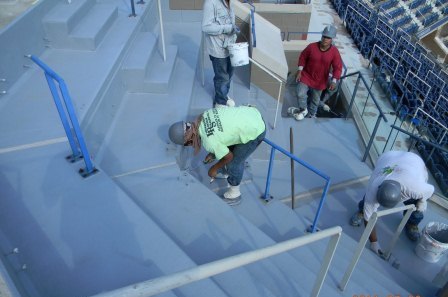Each year, tens of thousands of spectators converge at the Arthur Ashe Stadium, located in Flushing, NY, to witness the U.S. Open, the last of the four Grand Slam tournaments and one of the most anticipated events in the sport of tennis. What these tennis enthusiasts don’t realize is that in the months leading up to the tournament, a crew from Infrastructure Repair Service (IRS) is hard at work for the United States Tennis Association (USTA), repairing and recoating the concrete within the stadium.
According to John Lambe, general superintendent of IRS, over the last four years, he and his crew have worked on approximately 120,000 square feet (11,148 m²) of concrete substrate at Arthur Ashe Stadium between the months of March and mid-August. “The first year, we worked on the upper promenade level in the seating areas and main walkways. We also worked on the bathrooms and kitchen on that level. During the second year, we worked on the mezzanine seating area, and in the third year, we recoated the court level seating area and main walkways, as well as the outdoor pavilion and club level suites. This year, we are working on the mezzanine suites and the food preparation areas on that level,” explained Lambe. Although the condition of the concrete may differ from area to area within the stadium, much of the substrate is in need of repair.
Warming up for the Big Event
Prior to beginning any coating work, the crew, which varied in size from 6 to 30 depending on the task at hand, had to remove the existing coating and prep the concrete substrate. They also had to remove the seats in the areas where they needed to work. In some cases, this proved to be relatively easy, simply shifting seats up a few rows. However, in other areas of the stadium, the logistics were a bit more complicated.
“For the courtside seats, we had to remove the seats out of the seating area entirely and place them on the main walkways while we were working. And this year in the mezzanine suites, there is no access above or below. For these areas, we have to do one room at a time, moving everything into another suite while we work in that area,” said Lambe.
 With the seats out of the work area, the IRS team then removed the old, failed coating using a special segmented diamond wheel cup on a seven-inch (18 cm) Bosch angle grinder. In some larger areas, the existing coating was also removed with a Blastrac ride-on scraper. All deteriorated concrete was removed with pneumatic chipping hammers. “Where necessary, we repaired the concrete using Sika 1000 fast-setting concrete mix,” said Lambe. The crew also power washed all areas with a 5,000 psi (35 MPa) pressure washer and a cleaner manufactured by Neogard, the maker of the coatings used on the concrete stadium floors.
With the seats out of the work area, the IRS team then removed the old, failed coating using a special segmented diamond wheel cup on a seven-inch (18 cm) Bosch angle grinder. In some larger areas, the existing coating was also removed with a Blastrac ride-on scraper. All deteriorated concrete was removed with pneumatic chipping hammers. “Where necessary, we repaired the concrete using Sika 1000 fast-setting concrete mix,” said Lambe. The crew also power washed all areas with a 5,000 psi (35 MPa) pressure washer and a cleaner manufactured by Neogard, the maker of the coatings used on the concrete stadium floors.
Keeping It All Straight
With the concrete substrate prepped and ready to go, the crew could begin applying the Neogard coating systems. However, this is where things got a bit tricky. Depending on the area to be coated, there were several different Neogard products that were used throughout the stadium. Regardless of the coating system the substrate received, all coatings were applied with squeegees and then back-rolled.
For the mezzanine, promenade, and club level seating areas, the team laid down the following:
-
 Neogard 70410 at 60 square feet per gallon (2,445 L/m²)
Neogard 70410 at 60 square feet per gallon (2,445 L/m²)
- Neogard 7430 at 150 square feet per gallon (6,112 L/m²)
- 8 lbs. (4 kg) broadcast sand per 100 square feet (9 m²)
- Neogard 7430 at 100 square feet per gallon (4,075 L/m²)
- 15 lbs. (7 kg) broadcast sand per 100 square feet (9 m²)
- Neogard 7430 at 100 square feet per gallon (4,075 L/m²)
The restroom and concession stands at the promenade level received two different coating systems, depending on whether they had sandwich slab (a waterproofing layer in between the concrete layers) or structural slab. For the restrooms and concession stands with sandwich slab, the crew laid down:
- Neogard’s penetrating primer at 80 square feet per gallon (3,260 L/m²)
- 5 lbs. (2 kg) broadcast sand per 100 square feet (9 m²)
- Neogard 70714-15 epoxy primer at 300 square feet per gallon (12,224 L/m²)
- 5 lbs. (2 kg) broadcast sand per 100 square feet (9 m²)
- Neogard’s solvent-based urethane coat 70410 at 60 square feet per gallon (2,445 L/m²)
- Neogard 70714-15 at 150 square feet per gallon (6,112 m²)
- 8 lbs. (4 kg) broadcast sand per 100 square feet (9 m²)
- Neogard 70714-15 at 100 square feet per gallon (4,075 L/m²)
- 15 lbs. (7 kg) broadcast sand per 100 square feet (9 m²)
- Neogard 70714-15 at 100 square feet per gallon (4,075 L/m²)
“This same coating system was used in the club level suites, the seating area of the outdoor pavilion, and the mezzanine suites as well,” explained Lambe.
For the restrooms with structural slab at the promenade level, the team laid down the following:
- Neogard 7760/7761, a solvent-based epoxy primer at 60 square feet per gallon (2,445 L/m²)
- Neogard 70410 basecoat at 60 square feet per gallon (2,445 L/m²)
- Neogard 70714-15 at 150 square feet per gallon (6,112 L/m²)
- 8 lbs. (4 kg) broadcast sand per 100 square feet (9 m²)
- Neogard 70714-15 at 100 square feet per gallon (4,075 L/m²)
- Neogard 70714-15 at 100 square feet per gallon (4,075 L/m²)
“We also applied these coatings to the outdoor pavilion kitchen and bar area,” said Lambe. He goes on to add that in addition to the floor coatings, each year the team repairs and recoats the interior and exterior of the concrete walls in the areas in which they are working. “We remove the existing coating and then apply two coats of Conproco’s Complastic coating to the concrete block walls. We hand-roll both coats, with the first layer applied at 70 square feet per gallon [2,852 L/m²] and the second layer applied at 120 square feet per gallon [4,889 L/m²]” stated Lambe.
Never a Dull Moment
 As if keeping the coating systems straight wasn’t enough of a logistical challenge, each year the crew has to contend with a variety of issues, including some significant workarounds. According to Lambe, during the first year they worked at the stadium, they had to deal with rain — a lot of rain. “We had 40 days of rain, so we had many days where we couldn’t work. Also, we had to conduct moisture tests before we could apply any coatings to the substrate. That year, we had 20 guys coming in every Saturday from May until right before the U.S. Open so we could finish on schedule,” said Lambe.
As if keeping the coating systems straight wasn’t enough of a logistical challenge, each year the crew has to contend with a variety of issues, including some significant workarounds. According to Lambe, during the first year they worked at the stadium, they had to deal with rain — a lot of rain. “We had 40 days of rain, so we had many days where we couldn’t work. Also, we had to conduct moisture tests before we could apply any coatings to the substrate. That year, we had 20 guys coming in every Saturday from May until right before the U.S. Open so we could finish on schedule,” said Lambe.
Another year, the crew had to coordinate with the installers of two large scoreboards, and this year a roof is being constructed over the stadium, so the IRS team is in constant contact with other construction crews, making sure they are aware of the work that is being done by other trades.
Contractor’s Favorite
According to Lambe, even with the logistical challenges that pop up year after year, he enjoys working for the USTA at Arthur Ashe Stadium. “It is a unique and fun job that I look forward to each year. I’ve been in the coatings industry for 30 years, and I’d say this is my favorite job,” revealed Lambe.
View more photos from this project: